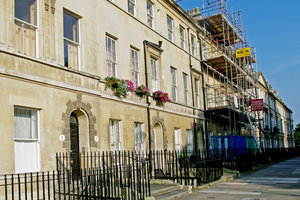Advertisement
Published: June 24th 2015

 Jane Austen's home
Jane Austen's home
...under the scaffolding, but similar to its neighboursAt “
Good Buy Books” Wednesday I bought a little book citing all the Jane Austen references to Bath, both fictional and from her life. And, at the Jane Austen Centre I bought a map showing where the sites were. So our object today was to walk in an effective route to photograph them all both for ourselves and for the Jasna Calgary
website. (We hope to find the time and energy to build our own
walking tour pageon the site.) The first site was just down the road and around the corner from our hotel. JA lived with her family at 4 Sydney Place – the only townhouse which was covered with scaffolding on this day! Just a challenge to photograph that’s all!
From here we followed our map through
Henrietta Gardens and beyond, in search of the church (
St. Swithin’s) where JA’s parents were married and father was buried. Up and along we did find it, although it was closed. We went into the south (downhill) garden to get a good perspective for our photos. As I came up again out of the garden, two women came out of the church and asked if we would like to see inside. Delighted, we entered a spacious,

 St Swithins
St Swithins
Still a parish churchlight church. The women told us it had recently been rehabilitated, which accounted for the warm cream paint, light oak pews and chairs, and clean bright stained glass windows.
The women showed us displays on the history of the church, including that it had been just missed by a huge landslip. We recalled that across the street and far down the road was a lovely grass-and-flowers park hanging on the side of the Bath cliff – all of this is the result of a terrible land slip that turned rows of townhouses into rubble.
We accepted their invitation to photograph the “marriage lines” of Jane Austen’s parents and of
William Wilberforce (anti-slave-trade campaigner). They also mentioned
George Austen’s grave/headstone and that of
Fanny Burney were in the church yard.
Another highlight this day was our tour of
No. 1 Royal Crescent. This wide, semi-oval row of tony townhouses is anchored at one end with a townhouse restored to the late 1700s. We learned that the whole Crescent was deteriorating into a derelict state when one man bought No. 1, and by his influence and his restoration efforts, the Crescent has become a wealthy residential area again. In the first room a (probably retired)

 The Royal Crescent
The Royal Crescent
Now a beautiful sweep of condoswoman handed us a plasticized sheet of information. On a whim, I said we would rather hear about the room from her, if she didn’t mind. She was so enthusiastic and knowledgeable that we asked the same of each woman overseeing each room. Thus we really came to appreciate how Eighteenth Century people of the upper middle class lived in Bath as visitors. The exhibit included the kitchen, well-stocked with many ingenious devices for cooking in a hearth.
After a couple of quick photos of the grounds, we deviated from our Jane Austen path. On Thursday’s uphill evening walk we noticed the Saracen’s Head pub, looking very old. Deirdre checked it in her book and discovered that it was old when the young Charles Dickens wrote Pickwick Papers there. We enjoyed the atmosphere while eating “baguettes” (subs) and drinking Guinness (me) and Shandy (Deirdre).
The rest of the afternoon we traipsed up and along a lot of streets, finding and taking photos of JA sites. Exhausted we returned to the hotel for tea.
For dinner we had planned to go to a pub in the city centre that advertised traditional roast beef dinner “all day” and “every

 The Saracen's Head
The Saracen's Head
Inside a historic pub, where they don't take Charles Dickens too seriouslyday” (most only do roast on Sundays). Apparently “all day” means “day time”, because it was closed. We wandered quite a bit, but since it was after 7:00, places were either closed or expensive. We turned back to our hotels area to eat at the Curry House again. This time we got two different chicken and lamb dishes, and we received more papadoms with our order, plus relishes. Very good.
View
map of trip to date.
View
map of Bath walking tour.
Advertisement
Tot: 0.659s; Tpl: 0.017s; cc: 30; qc: 46; dbt: 0.2798s; 1; m:domysql w:travelblog (10.17.0.13); sld: 2;
; mem: 1.3mb

















Isabel Gibson
non-member comment
Walking tours
I love walking tours. I understand the internet has dramatically changed them (in large markets anyway), with apps for sale that guide you on your (presumably) smart phone, providing commentary as you go. Your idea of getting the live version from the on-site volunteers/staff was an inspiration - I bet it made their day, too.